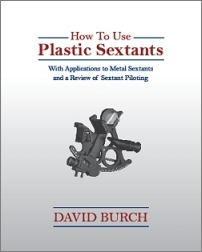 |
 |
 |
||||
Plastic sextants are practicable at sea, and preferable near land for piloting.
This book shows why.
|
How to use Plastic Sextants — with Applications to Metal Sextants and a Review of Sextant Piloting by David Burch
ISBN 9780914025245
$19.95 ...item# 1840psb
|
 |
|
Plastic sextants are often disparaged for lack of inherent accuracy and vulnerability to the effects of the sun, but these criticisms
are typically overstated. While it is true they are not as accurate as metal sextants and they are indeed more sensitive to the sun
than metal sextants are, plastic sextants can with special care still be used quite successfully for practical navigation at sea, and
they provide a less-expensive alternative to metal sextants, for both new navigators or seasoned mariners looking for a back up to
GPS. Plastic sextants are even preferable over metal ones for most sextant-piloting applications.
This book explains how to get the best results from these instruments, including step by step instructions for the sight taking, as well as numerical comparisons with metal sextants.
The focus of the book is on plastic sextants, because they present the biggest challenges, but if you master the use of them, you will be even much better with a metal sextant in your hand. In short, the sight taking and analysis procedures covered are the best way to do all sights, regardless of sextant style, it is just more crucial that we follow these procedures when using plastic sextants. This new edition now includes a detailed discussion of sextant piloting on inland and coastal waters, which is not covered in many texts these days. With an inexpensive plastic sextant you can pinpoint your position on a map or chart more accurately than you can with GPS—not to mention it is more reliable as well... (oops. We mentioned it!). |
|
